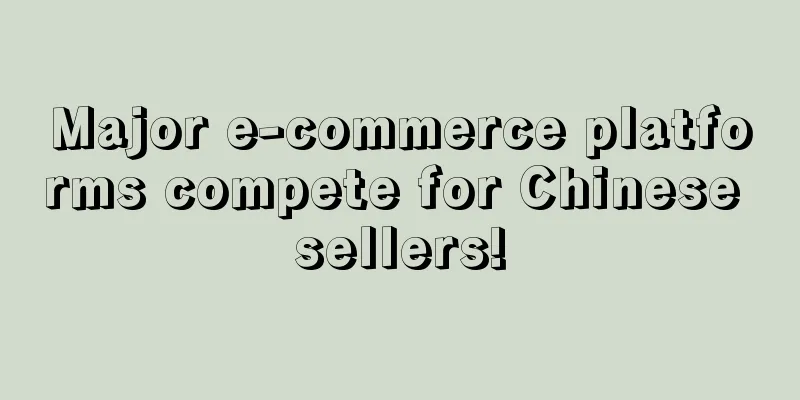Major e-commerce platforms compete for Chinese sellers!

|
Peace means win-win situation, while fighting means both sides lose!
Recently, Amazon has taken new action and announced the launch of the "2024 Amazon Export Cross-border Logistics Accelerator Program", which mainly improves cross-border logistics services for Chinese sellers in four aspects: cross-border logistics products, supply chain management, destination warehousing, and local team building.
Amazon has been working hard to establish cooperative relationships with Chinese sellers, and the platform's love for Chinese sellers has once again become concrete.
The well-known e-commerce giant eBay is no exception. At the same time, major e-commerce platforms around the world have extended olive branches to Chinese sellers .
Chinese sellers are living up to expectations and are rapidly taking over major e-commerce platforms around the world.
According to preliminary statistics from various regions, there are more than 120,000 cross-border e-commerce entities in China . On Amazon's US site, Chinese sellers account for nearly 50% of the top sellers, and this group contributes almost half of the third-party GMV. By the end of 2023, the number of sellers on Russian e-commerce giant Ozon has reached about 500,000, of which more than 100,000 are Chinese sellers, accounting for at least 20%. French e-commerce platform Cdiscount has more than 15,000 third-party sellers, of which about 5,000 are Chinese sellers , accounting for as much as one-third . …
The result is that both sides get what they want. Chinese sellers want to find new profit points, and e-commerce platforms also want to gain competitive advantages by relying on China's abundant and cheap goods. With the core position of "world factory", Chinese sellers are closely connected with major e-commerce platforms and continue to create sales miracles.
Hidden dangers are also lurking around.
The game between sellers is endless. " Involution " is a well-known term in various industries, but this word continues to be a special term for Chinese sellers in the cross-border circle. A group of Chinese sellers overseas are involuntarily involuntarily killing others and themselves. The relationship between platforms and sellers is also continuously tense. Some platforms charge a variety of fees and impose severe fines on layer by layer of exploitation ... Under the confrontation, vicious results continue to emerge. Platforms and seller groups continue to advance in the zero-sum game, and will eventually either slowly move towards symbiosis or both sides will suffer!
With favorable policies added, major e-commerce platforms are competing for Chinese sellers!
Major cross-border e-commerce platforms around the world are stepping up efforts to attract Chinese sellers to join .
In March this year , Walmart held its first seller summit in Shenzhen, where heads of various management departments of Walmart's global e-commerce and the official investment promotion team took turns to attend and promote the event.
One month ago, Walmart launched the Chinese version of its seller platform, allowing sellers to submit support cases in Chinese. The platform is also running a test program to simplify the import of its logistics service WFS... These measures are specifically designed to facilitate Chinese sellers. In order to attract Chinese sellers to join, Walmart has made great efforts.
In the past two years, Polish e-commerce giant Allegro has also set its sights on Chinese sellers. It not only provides free seller training and professional Chinese support for Chinese sellers, creates a Chinese help center, but also simplifies the entry process for Chinese sellers. Chinese sellers do not need to provide translation documents to enter Allegro, but can directly upload the original Chinese documents.
Similar measures are also being continuously adopted by other e-commerce platforms around the world. Favorable policies are constantly being added, and the investment promotion effect is significant.
In April, three-quarters of new sellers on Walmart’s marketplace came from China, surpassing the previous record of 67% set in March. In March 2021, Walmart began allowing international sellers , but with the exception of a small number of sellers in India, Canada, the United Kingdom, and Vietnam, most international sellers are located in China.
The number of Chinese sellers on the Ozon platform is also rising sharply.
In November 2022, Ozon opened its China headquarters office in Shenzhen and officially recruited Chinese sellers. It plans to attract more than 100,000 Chinese sellers by 2024 and increase the turnover from Chinese sellers by 10 times. Now the plan has been successfully realized and the completion time has been brought forward to the end of 2023.
Long before e-commerce platforms such as Walmart, Ozon , and Allegro entered the Chinese market, e-commerce platforms such as Wish, eBay, and Amazon had already discovered the shining points and value of Chinese sellers.
Amazon is the undisputed "king" of today's cross-border e-commerce platforms, but the cross-border journey of many Chinese sellers began on eBay. As early as around 2010, a group of Chinese sellers were selling goods on the eBay platform. With cheap logistics, the platform's relaxed development policies, and the bonus period at the initial stage of the cross-border e-commerce industry, Chinese sellers have the energy to go overseas with ease beyond imagination, and everyone is happy to ship goods: "The bigger the ambition, the bigger the stage"!
In 2011, Wish, a platform known for its low prices and known as the "American version of Pinduoduo", was launched. Soon after its establishment, Wish focused on Chinese sellers, and eventually Chinese sellers were everywhere on the platform. Marketplace Pulse data shows that on Wish, a mobile shopping platform with hundreds of thousands of sellers, the proportion of Chinese sellers once reached 94%, and the rest of the sellers were distributed all over the world.
In the initial stage, Chinese sellers and the Wish platform had a relationship of mutual growth: Chinese sellers lived a prosperous life of "orders coming in as soon as the products were put on the shelves". In 2014, the Wish platform, which was opened to Chinese sellers, has successfully obtained US$69 million in venture capital from Wall Street.
With the rise of Wish, Amazon, which once ignored Chinese sellers, realized the importance of this group. In 2015, Amazon quickly launched the "Marco Polo" plan, formed a Beijing team to sign contracts with Chinese sellers, translated the "Seller Center" into Chinese characters, and provided them with real-time customer support.
Reliable data shows that from 2015 to 2016, thousands of Chinese sellers successfully registered on the Amazon platform every day.
Chinese sellers are not only helping Wish, but are also giving back to other e-commerce platforms such as Amazon.
It is understood that Chinese sellers contribute 90% of Ozon's cross-border transaction volume. Chinese sellers can be found in all categories of the platform, especially in the three best-selling evergreen categories of clothing, household goods and children's products, where Chinese sellers have the largest share.
China's "Four Little Dragons Going Global" (Temu, SHEIN, TikTok, and AliExpress) continue to launch a fierce attack on overseas markets, and their combined GMV has approached 10% of the US e-commerce market share. Among them, SHEIN and Temu have made significant progress in the United States in less than two years. There are signs that the two platforms have already "cannibalized" Amazon's business. According to Sensor Tower data, since its overseas launch in September 2022, the number of Temu users has grown to 51.4 million in January this year, while Amazon's users have fallen from 69.6 million in September last year to 67 million.
Chinese sellers are even more important to Amazon. eCommerceDB pointed out that the proportion of Chinese sellers on Amazon has been increasing year by year, and GMV (gross merchandise volume) has been increasing year by year.
In 2017, the GMV of Chinese sellers on Amazon was $48 billion, which was equivalent to 18% of Amazon's total GMV. In 2022, the GMV of Chinese sellers reached $201 billion, an increase of 300%, accounting for 26% of Amazon's total GMV. eCommerceDB predicts that by the end of 2023, the total GMV of Chinese sellers will reach $238 billion, accounting for 28% of Amazon's total GMV. That is to say, on the Amazon platform, one out of every four sellers is a Chinese seller, and the actual number may be even higher because the platform is also full of Chinese stores registered with American information.
Now, Chinese sellers account for nearly 50% of the best-selling products on the Amazon platform . Earlier this year, Amazon acknowledged for the first time the market share of Chinese sellers on its market, calling it "significant." For this reason, when Amazon submitted its annual 10-K form to the U.S. Securities and Exchange Commission, it also listed Chinese sellers in the risk warning facing its international business.
Amazon says : Because Chinese sellers account for a significant portion of our third-party seller services and advertising revenue and Chinese suppliers provide a significant portion of our components and finished products, our operating results could be adversely affected by regulatory and trade restrictions, data protection and cybersecurity laws, economic factors, geopolitical events, security issues or other factors that negatively affect Chinese sellers and suppliers.
Despite this, Amazon still cannot get rid of its "heavy dependence" on Chinese sellers .
"If all the Chinese sellers are driven away, Amazon's stock price will plummet," threatened many industry insiders.
The same is true for other platforms. Chinese sellers and major e-commerce platforms are running in both directions. On the one hand, everyone is trying their best to maintain order on the platform and eliminate illegal merchants, while on the other hand, they are appeasing white hat sellers.
Simon Huang, head of Ozon China, publicly stated that developing business in China will bring Ozon a significant increase in the number of high-quality brands and sellers, and expand the platform's product categories and SKU numbers.
Made in China is one of the most recognized labels in the world. Among the world's 500 major industrial products, China ranks first in the world in terms of output of more than 40% of its products. In 2001, China joined the WTO. With its low comprehensive factor cost, Made in China has become the value depression of the world's manufacturing production cost, attracting manufacturing enterprises in developed countries to transfer their industries to China, and it soon became the "world factory".
Peace is a win-win situation, while conflict is a loss! The next stage of cross-border e-commerce development
Backed by strong supply chain resources, Chinese sellers have a natural advantage in cross-border sales of products in terms of price and sales of high-quality products. More and more overseas consumers are highly favoring Chinese-made products.
Ideally, Chinese sellers use cross-border e-commerce platforms as a vehicle to continuously "harvest" overseas consumers, and cross-border e-commerce platforms leverage the performance of Chinese sellers to take off. This is a win-win situation.
However, as cross-border e-commerce expands rapidly, it is not uncommon for things to get out of control.
The reason why most Chinese sellers can "do a big job" overseas is that they take advantage of the powerful advantages of China's supply chain to continuously lower the prices of their products. When using low-price "killer weapons" to snatch consumers, there are always some people who continue to break the price bottom line.
Especially on the Amazon platform, "strategic losses" is a very common strategy, also known as the spiral strategy. The specific process is as follows: first sell products at ultra-low prices or even at a loss to quickly improve product rankings; when the product ranking is successfully ranked high, slowly increase the product price in order to make more money later.
Although Chinese sellers widely criticize the spiral strategy, believing that "to squeeze others is also to squeeze yourself", such a zero-sum game is not a long-term solution and will only end up in a lose-lose situation. In the end, the only ones who may be hurt are Chinese sellers "their own people" and the entire Chinese cross-border e-commerce industry.
But involution has never disappeared.
An industry insider bluntly said that in the current business environment, it is difficult to stay out of trouble. If you don't involute, there will always be competitors who want to take "shortcuts", and reality will "teach you a lesson" every minute. He likened involuntariness to a bowl of poison. Drinking it may be a temporary solution, but not drinking it may also mean that you will not live long.
Competition among cross-border e-commerce sellers is becoming increasingly fierce. With products being highly homogenized with peers, it is not uncommon for a bunch of competitors to attack with low prices as soon as the products are put on the shelves. If the products cannot be sold, they will become a pile of unprofitable inventory. FBA warehouses are piled with a lot of dead inventory, and not only will Amazon charge them long-term storage fees and other fees, but they will also have to pay to remove and abandon the products. Even if the goods are transferred to overseas warehouses, it is difficult to ship this batch of goods, which was originally expected to be high, back to China because the cost is very high.
Selling unprofitable products at a low price at a loss has become the unanimous choice of many sellers.
As cross-border e-commerce begins to move towards the next stage, internal circulation continues to follow closely.
For a long time, the goods produced by Chinese factories have filled the shelves of retailers and brands in the United States. The emergence of full-hosting and semi-hosting models has lowered the threshold for cross-border e-commerce to go overseas . Factories that used to produce products for large supermarkets such as Walmart can now sell their products directly to a large number of consumers through the sales model built by cross-border e-commerce platforms. Even local bosses who do not understand English can go overseas without worries .
Compared with middle traders, source factories with more price advantages are obviously more likely to win the hearts of consumers. The overall sales price of cross-border e-commerce has been further lowered, and the already meager profits of some sellers have been further reduced ...
An industry insider , "Factory Manager in the Wind" , believes that e-commerce has not reached its peak yet. An ideal business society should have transparent prices in every link, consumers should know clearly the production costs of factories and the channel costs of middlemen, and most industries should no longer have super high profits. This so-called ideal state is the most competitive, and we are currently approaching it step by step.
Wish is a typical case that must be mentioned.
In April this year , Qoo10 completed its acquisition of Wish. Qoo10 Pte. Ltd. currently owns and operates the Wish platform and all ContextLogic subsidiaries related to the Wish e-commerce platform. Wish, once a popular platform that was once known as one of the four major cross-border e-commerce platforms along with Amazon, eBay, and AliExpress , has fallen behind without anyone noticing.
Wish 's sale was completed, but it failed to make much of a splash in the cross-border circle, and instead received a lot of criticism.
"Cheap" has been the label that has followed Wish since its establishment . At the same time, Chinese sellers have also witnessed the glory and decline of this platform.
Unlike its current "notoriety", Wish platform had a good reputation among Chinese sellers at the beginning because the rules on the platform were relatively fair. The reason of "gradually ignoring Chinese sellers during the development process" was considered by industry insiders to be the main reason for the tilt of the balance between sellers and the platform.
A seller named Xiao Zhang who used to work on Wish said that the platform was too small, and his own popular products with sales of tens of thousands of units were directly copied by the platform, and even the reviews were imported into the self-operated stores. "Self-operated stores openly snatched the business of third-party sellers" was not enough. Then, whether it was unreasonable fine policies, logistics monopoly, or mandatory refund policies, they were all breaking his heart step by step...
Xiao Li feels the same way. In 2018 , he was fined tens of thousands of dollars due to logistics policies. Among them, he was fined 100 US dollars for failing to change the order number in time for each order.
Xiao Li once said: It is difficult for this e-commerce platform not to "collapse"! Every time news about Wish leaks out, there are always similar voices below. Each platform has its own core competitiveness. What is Wish's core competitiveness? The answer given by a large number of Wish sellers is - no core competitiveness.
"The ultimate goal of Chinese sellers joining the platform is to make money. The platform only wants to make money from the sellers. The sellers can't stand the exploitation and have to withdraw. With fewer sellers, there will be fewer products, and consumers on the platform will continue to leave." Xiao Li said that without the support of Chinese sellers, the platform's failure is only a matter of time.
Now, sellers are shifting their criticism of Wish to other platforms. Everyone knows who is the one who gets criticized the most.
Industry insiders believe that if the platform only treats sellers as a tool for supplying goods, and uses price as the only criterion for measuring the quality of products, when the full-trusteeship model grows to a certain extent, traders will continue to be squeezed out, leaving only the factories that directly connect to upstream. By then, the factories will not have an easy time either, because this group will become the next target of further exploitation by the platform.
This abnormal model of the platform squeezing merchants is doomed to fail, and in the end, it will only be a lose-lose situation.
Even with significant supply chain advantages. The number of living things on the land is limited, and the number of human resources is limited. If you take them in moderation and use them in moderation, you will always have enough. If you take them without moderation and use them without moderation, you will always have insufficient resources. Resources are limited, whether human or material resources, they need to be reasonably utilized, allocated, and used, and you cannot fish out all the fish in the pond.
The platform needs to listen to the sellers’ voices, and the profits should be returned to the merchants, so that they have the motivation to develop and innovate . Only platforms that know how to make concessions can coexist peacefully with sellers for a long time and put themselves in an invincible position.
The platform needs to constantly explore ways to get along with merchants, and what merchants need to explore is how to get along with the future.
The times have pushed cross-border e-commerce sellers to seek change. Just as the distribution of goods was once popular, it is now dominated by branding and refined operations. In the view of the factory manager in Fengzhong and other industry insiders, the way out for merchants in the future is either to cut all kinds of unnecessary costs and make products extremely cheap. Or to build a brand and take the route of quality-price ratio to meet the needs of a certain group. Each of them should do their own segmentation, the cheap ones should run in volume, and the expensive ones should focus on quality. No matter when cross-border e-commerce is, consumers have enough choices , and the core competitiveness of merchants in the end is often just product strength and brand strength .
Fortunately, a group of sellers have obviously awakened. Saying goodbye to the era of disorder, they actively seek change and embrace the new era of cross-border e-commerce. Regardless of the overall environment, the pace of China's cross-border e-commerce going overseas is still accelerating ...
|
Recommend
A batch of accounts were shut down, and Amazon's system was complained about
Around the National Day holiday, Amazon struck ou...
Fined over 200 million! Amazon has suffered a series of setbacks recently
According to foreign media reports, on June 29, t...
What is Mingshisu International Freight? Mingshisu International Freight Review, Features
Mingshisu International Freight is an internation...
How to attract traffic to independent websites: Business social networking with the rise of overseas social media (Part 1)
Mastercard data found that during the pandemic , ...
Sales soared 200%! Maternal and infant products are popular again, Tokopedia launches a new system
Tokopedia’s flagship product Maternal and infant ...
Consumers’ purchasing behavior has changed, and these platforms are gaining popularity!
I believe that all sellers are familiar with Buy ...
What is GoAllPay? GoAllPay Review, Features
GoAllPay is an aggregated payment service platform...
Search volume soared 28236%, Etsy home products ushered in a big boom
The 2020 epidemic has prompted more consumers to ...
Annual sales exceed 100 million! Niche sellers overtake others in the red ocean market
As the industry landscape continues to change, mo...
What is M2E Pro? M2E Pro Review, Features
Founded in 2009, M2E Pro is a large-scale Magento...
What is Wangdao Overseas Warehouse? Wangdao Overseas Warehouse Review, Features
Wangdao has more than 5 years of professional cros...
DHL and Cargojet partner to strengthen air network
Recently, DHL announced that it has reached a new...
Amazon's warehouses are overflowing! Prime Day countdown is approaching, but sellers have no goods to sell...
The "Battle of Member Day" is about to ...
What is 1210? 1210 Review, Features
<span data-docs-delta="[[20,{"gallery"...
The funds involved exceeded 21 million, and Zebao was sued again
A top-selling product is also a lot of lawsuits. ...









